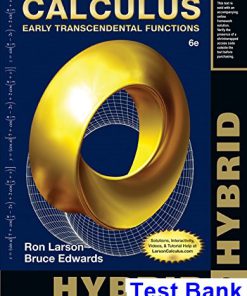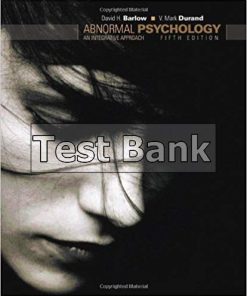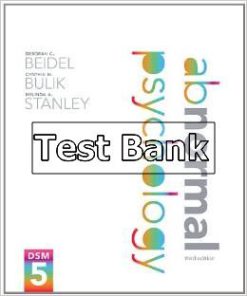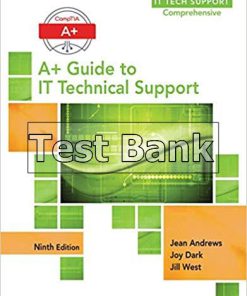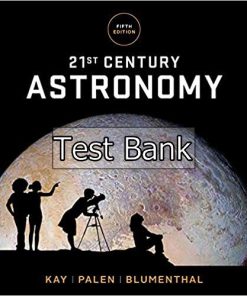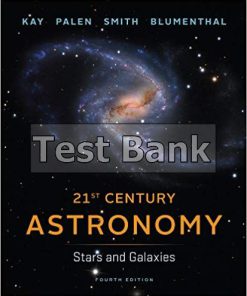Calculus Early Transcendental Functions 6th Edition Larson Test Bank
$26.50$50.00 (-47%)
Calculus Early Transcendental Functions 6th Edition Larson Test Bank.
You may also like
Calculus Early Transcendental Functions 6th Edition Larson Test Bank

Product details:
- ISBN-10 : 1285774779
- ISBN-13 : 978-1285774770
- Author: Dr. Ron Larso
Designed for the three-semester engineering calculus course, CALCULUS: EARLY TRANSCENDENTAL FUNCTIONS, Sixth Edition, continues to offer instructors and students innovative teaching and learning resources. The Larson team always has two main objectives for text revisions: to develop precise, readable materials for students that clearly define and demonstrate concepts and rules of calculus; and to design comprehensive teaching resources for instructors that employ proven pedagogical techniques and save time. The Larson/Edwards Calculus program offers a solution to address the needs of any calculus course and any level of calculus student. Every edition from the first to the sixth of CALCULUS: EARLY TRANSCENDENTAL FUNCTIONS has made the mastery of traditional calculus skills a priority, while embracing the best features of new technology and, when appropriate, calculus reform ideas.
Table contents:
- Chapter 1: Preparation for Calculus
- 1.1: Graphs and Models (57)
- 1.2: Linear Models and Rates of Change (64)
- 1.3: Functions and Their Graphs (65)
- 1.4: Fitting Models to Data (21)
- 1.5: Inverse Functions (59)
- 1.6: Exponential and Logarithmic Functions (61)
- 1: Review Exercises
- 1: Problem Solving
- Chapter 2: Limits and Their Properties
- 2.1: A Preview of Calculus (22)
- 2.2: Finding Limits Graphically and Numerically (58)
- 2.3: Evaluating Limits Analytically (65)
- 2.4: Continuity and One-Sided Limits (61)
- 2.5: Infinite Limits (54)
- 2: Review Exercises
- 2: Problem Solving
- Chapter 3: Differentiation
- 3.1: The Derivative and the Tangent Line Problem (54)
- 3.2: Basic Differentiation Rules and Rates of Change (71)
- 3.3: Product and Quotient Rules and Higher-Order Derivatives (81)
- 3.4: The Chain Rule (103)
- 3.5: Implicit Differentiation (63)
- 3.6: Derivatives of Inverse Functions (49)
- 3.7: Related Rates (50)
- 3.8: Newton’s Method (48)
- 3: Review Exercises
- 3: Problem Solving
- Chapter 4: Applications of Differentiation
- 4.1: Extrema on an Interval (55)
- 4.2: Rolle’s Theorem and the Mean Value Theorem (55)
- 4.3: Increasing and Decreasing Functions and the First Derivative Test (70)
- 4.4: Concavity and the Second Derivative Test (59)
- 4.5: Limits at Infinity (68)
- 4.6: A Summary of Curve Sketching (53)
- 4.7: Optimization Problems (58)
- 4.8: Differentials (44)
- 4: Review Exercises
- 4: Problem Solving
- Chapter 5: Integration
- 5.1: Antiderivatives and Indefinite Integration (69)
- 5.2: Area (64)
- 5.3: Riemann Sums and Definite Integrals (64)
- 5.4: The Fundamental Theorem of Calculus (99)
- 5.5: Integration by Substitution (73)
- 5.6: Numerical Integration (57)
- 5.7: The Natural Logarithmic Function: Integration (85)
- 5.8: Inverse Trigonometric Functions: Integration (76)
- 5.9: Hyperbolic Functions (77)
- 5: Review Exercises
- 5: Problem Solving
- Chapter 6: Differential Equations
- 6.1: Slope Fields and Euler’s Method (69)
- 6.2: Differential Equations: Growth and Decay (66)
- 6.3: Differential Equations: Separation of Variables (84)
- 6.4: The Logistic Equation (37)
- 6.5: First-Order Linear Differential Equations (70)
- 6.6: Predator-Prey Differential Equations (20)
- 6: Review Exercises
- 6: Problem Solving
- Chapter 7: Applications of Integration
- 7.1: Area of a Region Between Two Curves (67)
- 7.2: Volume: The Disk Method (67)
- 7.3: Volume: The Shell Method (41)
- 7.4: Arc Length and Surfaces of Revolution (61)
- 7.5: Work (36)
- 7.6: Moments, Centers of Mass, and Centroids (52)
- 7.7: Fluid Pressure and Fluid Force (22)
- 7: Review Exercises
- 7: Problem Solving
- Chapter 8: Integration Techniques, L’Hôpital’s Rule, and Improper Integrals
- 8.1: Basic Integration Rules (52)
- 8.2: Integration by Parts (61)
- 8.3: Trigonometric Integrals (51)
- 8.4: Trigonometric Substitution (51)
- 8.5: Partial Fractions (41)
- 8.6: Integration by Tables and Other Integration Techniques (51)
- 8.7: Indeterminate Forms and L’Hôpital’s Rule (70)
- 8.8: Improper Integrals (70)
- 8: Review Exercises
- 8: Problem Solving
- Chapter 9: Infinite Series
- 9.1: Sequences (39)
- 9.2: Series and Convergence (46)
- 9.3: The Integral Test and p-Series (33)
- 9.4: Comparisons of Series (32)
- 9.5: Alternating Series (36)
- 9.6: The Ratio and Root Tests (47)
- 9.7: Taylor Polynomials and Approximations (36)
- 9.8: Power Series (39)
- 9.9: Representation of Functions by Power Series (37)
- 9.10: Taylor and Maclaurin Series (46)
- 9: Review Exercises
- 9: Problem Solving
- Chapter 10: Conics, Parametric Equations, and Polar Coordinates
- 10.1: Conics and Calculus (46)
- 10.2: Plane Curves and Parametric Equations (43)
- 10.3: Parametric Equations and Calculus (53)
- 10.4: Polar Coordinates and Polar Graphs (56)
- 10.5: Area and Arc Length in Polar Coordinates (54)
- 10.6: Polar Equations of Conics and Kepler’s Laws (38)
- 10: Review Exercises
- 10: Problem Solving
- Chapter 11: Vectors and the Geometry of Space
- 11.1: Vectors in the Plane (49)
- 11.2: Space Coordinates and Vectors in Space (59)
- 11.3: The Dot Product of Two Vectors (44)
- 11.4: The Cross Product of Two Vectors in Space (40)
- 11.5: Lines and Planes in Space (59)
- 11.6: Surfaces in Space (39)
- 11.7: Cylindrical and Spherical Coordinates (57)
- 11: Review Exercises
- 11: Problem Solving
- Chapter 12: Vector-Valued Functions
- 12.1: Vector-Valued Functions (45)
- 12.2: Differentiation and Integration of Vector-Valued Functions (46)
- 12.3: Velocity and Acceleration (42)
- 12.4: Tangent Vectors and Normal Vectors (49)
- 12.5: Arc Length and Curvature (49)
- 12: Review Exercises
- 12: Problem Solving
- Chapter 13: Functions of Several Variables
- 13.1: Introduction to Functions of Several Variables (42)
- 13.2: Limits and Continuity (41)
- 13.3: Partial Derivatives (63)
- 13.4: Differentials (41)
- 13.5: Chain Rules for Functions of Several Variables (37)
- 13.6: Directional Derivatives and Gradients (45)
- 13.7: Tangent Planes and Normal Lines (35)
- 13.8: Extrema of Functions of Two Variables (48)
- 13.9: Applications of Extrema (44)
- 13.10: Lagrange Multipliers (44)
- 13: Review Exercises
- 13: Problem Solving
- Chapter 14: Multiple Integration
- 14.1: Iterated Integrals and Area in the Plane (62)
- 14.2: Double Integrals and Volume (49)
- 14.3: Change of Variables: Polar Coordinates (46)
- 14.4: Center of Mass and Moments of Inertia (42)
- 14.5: Surface Area (34)
- 14.6: Triple Integrals and Applications (46)
- 14.7: Triple Integrals in Other Coordinates (42)
- 14.8: Change of Variables: Jacobians (42)
- 14: Review Exercises
- 14: Problem Solving
- Chapter 15: Vector Analysis
- 15.1: Vector Fields (47)
- 15.2: Line Integrals (46)
- 15.3: Conservative Vector Fields and Independence of Path (40)
- 15.4: Green’s Theorem (40)
- 15.5: Parametric Surfaces (43)
- 15.6: Surface Integrals (43)
- 15.7: Divergence Theorem (29)
- 15.8: Stokes’s Theorem (32)
- 15: Review Exercises
- 15: Problem Solving
- Chapter 16: Additional Topics in Differential Equations (online only)
- 16.1: Exact First-Order Equations (48)
- 16.2: Second-Order Homogeneous Linear Equations (45)
- 16.3: Second-Order Nonhomogeneous Linear Equations (42)
- 16.4: Series Solutions of Differential Equations (27)
- Chapter A: Appendices
- A.A: Proofs of Selected Theorems
- A.B: Integration Tables
- A.C: Precalculus Review (Web)*
- A.D: Rotation and the General Second-Degree Equation (Web)*
- A.E: Complex Numbers (Web)*
- A.F: Business and Economic Applications (Web)*
- Chapter QP: Quick Prep Topics
- QP.1: Definition and Representations of Functions (15)
- QP.2: Working with Representations of Functions (16)
- QP.3: Function Notation (15)
- QP.4: Domain and Range of a Function (14)
- QP.5: Solving Linear Equations (16)
- QP.6: Linear Functions (17)
- QP.7: Parabolas (15)
- QP.8: Factoring Quadratic Equations and Finding x-intercepts of a Quadratic Function (14)
- QP.9: Polynomials (19)
- QP.10: More about Factoring Polynomials (14)
- QP.11: Finding Roots (16)
- QP.12: Dividing Polynomials (16)
- QP.13: Rational Functions (21)
- QP.14: Root Functions (17)
- QP.15: Rationalizing the Numerator or Denominator (13)
- QP.16: Exponential Functions (15)
- QP.17: Logarithmic Functions (17)
- QP.18: Trigonometric Functions and the Unit Circle (17)
- QP.19: Graphs of Trigonometric Functions (17)
- QP.20: Trigonometric Identities (20)
- QP.21: Special Functions (14)
- QP.22: Algebraic Combinations of Functions (16)
- QP.23: Composition of Functions (15)
- QP.24: Transformations of Functions (14)
- QP.25: Inverse Functions (19)
People also search:
calculus early transcendental functions 6th edition
calculus early transcendental functions 6th edition answers
calculus early transcendental functions 6th edition pdf
calculus early transcendental functions 6th edition solutions
calculus early transcendental functions 6th edition quizlet






